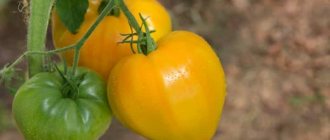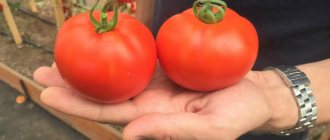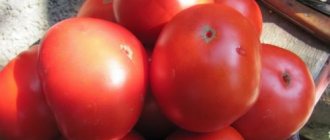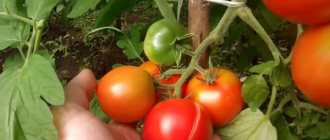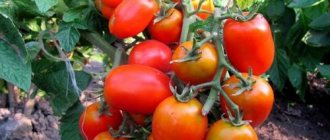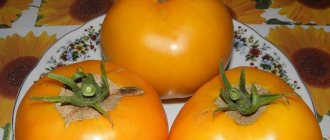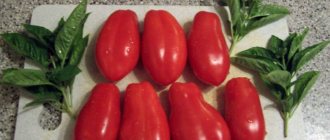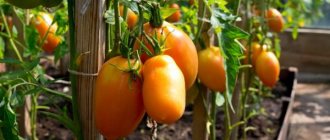Summer resident tomatoes: description of an easy-to-care tomato, photo of the harvest, reviews from those who planted the variety
When growing garden crops, many summer residents dream of varieties that could be planted in the beds and forget about caring for them. Some will say that such cultivated plants do not exist. But this is only because not all vegetable growers have heard about the Dachnik tomato variety.
The Dachnik tomato variety is not distinguished by its high yield, unusual size or coloring of fruits, and farmers who grow tomatoes on an industrial scale are unlikely to be interested in it. But for vegetable growers who grow vegetables in their small garden, the Dacha tomato will truly be a godsend - the productivity of this variety is average, but stable in all weather conditions, and even a person who has never grown vegetable crops before can grow Dacha tomatoes in their garden.
The content of the article:
1. History of the creation of the variety 2. Main characteristics and description of the variety 3. Productivity of the variety 4. Diseases and pests 5. Advantages and disadvantages 6. Planting Summer Resident tomatoes 7. Further care 8. Feeding 9. Reviews of Summer Resident tomatoes
Characteristics of tomatoes
The fruits of the Dachnik variety have the following characteristics:
- The shape of tomatoes is standard flat-round without ribbing.
- During the period of technical ripening, the color of the fruits can be light green, and when ripe they acquire a bright red hue.
- The tomato pulp is pink-red, juicy, the skin is thin but quite dense. The number of cameras exceeds four. There is a characteristic tomato aroma. The dry matter content is 5.6%.
- Summer resident tomatoes are small in size, the average weight of one is 70-86 grams.
- The taste characteristics of the fruit are good, they have a slight sourness. Sugars make up about 3.3% of the total weight of tomatoes. And ascorbic acid is contained in an amount of 17 mg per 100 g of pulp.
- Tomatoes are universal in purpose, since they are good both fresh and in the form of any preparations.
- Tomatoes are distinguished by good preservation and suitability for long-term transportation.
- Since tomatoes ripen rather unevenly, the fruiting period is very extended, which is very convenient for summer residents who have the opportunity to collect tomatoes over a long period in small portions.
History of the variety's creation
Work on developing this variety was carried out by Russian breeders from the All-Russian Research Institute of Vegetable Growing at the end of the last century. The leader of the group of scientists was N. S. Gorshkova.
Photo of tomatoes Summer resident
A new variety was tested for several years. And only then the Dachnik tomato was entered into the Russian State Register in 1999.
This tomato is called Summer Resident. The originator of the variety was Agro, but currently the seeds of this tomato are produced by many other well-known Russian companies involved in the production and sale of vegetable seeds.
EXCELLENT VARIETIES OF TOMATOES!
Tomato Casanova Tomato Primadonna F1 Tomato Black Prince
However, sometimes confusion arises - there is also a tomato hybrid with the same name on sale, there are also other seeds of this vegetable crop, the name of which also contains the word summer resident - Ural summer resident, Summer resident of Kuban and some other varieties .
The Dachnik tomato variety is recommended for cultivation in the North Caucasus region, however, according to reviews from vegetable growers, these tomatoes grow well and bear fruit in garden beds in the Central regions of Russia, as well as in many regions of the Urals and Siberia.
Reviews from those who planted
Most reviews from gardeners and consumers who have encountered tomatoes of this variety are positive. Some gardeners believe that Dachnik tomatoes remind them of the Sanka tomato variety.
Galina Semenovna, Perm region
Elena Vasilievna, Orenburg region
Olga Lvovna, Penza region
Ekaterina Maksimovna, Kaliningrad region
Elena Alekseevna, Arkhangelsk region
Ekaterina Danilovna, Tomsk region
Tatyana Ivanovna, Ryazan region
Sergey Evgenievich, Voronezh region
Tomato Summer resident: main characteristics and description of the variety
Tomatoes of the Dachnik variety belong to the determinant type,
therefore, their bushes are compact and low (the central shoot reaches a height of 70-75 cm), they do not take up much space in the beds, but at the same time they are highly productive.
Photo of bushes with tomatoes Summer resident
It is not necessary to tie up the Summer Resident tomato bushes, but it should be taken into account that the shoots may fall to the ground or even break under the weight of ripening fruits.
But at the same time, the Dacha tomato bushes are very powerful and stocky, despite their compactness, and the same can be said about the seedlings of this variety.
Important!
Due to the compactness and small height of this tomato, the small size of ripe tomatoes and unpretentiousness to growing conditions, many vegetable growers grow the Dachnik variety on a glassed-in balcony or even a windowsill. At the same time, the yield of these tomatoes does not differ much from that of tomatoes grown in open ground.
Brief overview of Summer Resident tomatoes - video
The Summer Resident tomato was created specifically for growing in open ground beds and is adapted for normal fruiting even in adverse weather conditions.
The shoots of this variety are medium leafy and dark green in color. The foliage is less than medium in size, typically tomato-like, narrow, and deep emerald in color.
The inflorescences are formed in the internodes, they are racemose, the flowers are small, yellow. Each inflorescence produces up to 10 ovaries.
Pest and disease control
To prevent fungal diseases, bushes are treated with fungicides before the ovaries appear. In rainy summers, folk remedies are used weekly: whey or milk mixed with iodine. Fatty liquids envelop the leaf blade, preventing spores from settling. Sparse planting and removal of weeds prevents the appearance of aphids and whiteflies. Aphids are destroyed with soap or soda solutions. If whiteflies appear, the bushes are sprayed with infusions of tobacco, tomato tops, yarrow, and garlic.
Diseases and pests
This tomato is characterized by increased resistance to some diseases that affect other varieties of tomatoes - fusarium or blossom end rot of tomatoes.
Photos of tomatoes susceptible to late blight
However, this variety may be susceptible to late blight. But thanks to the early ripening of the crop, an outbreak of this disease appears after all the fruits from the Dachnik variety have already been harvested.
Similar varieties
The Dacha tomato is similar in characteristics to some other determinate crop types. But still they have some differences.
Similar varieties:
- Tomato Yablonka Russia. An early ripening variety for greenhouses and open ground, it needs pinching and tying. The height of the bushes reaches 1.3 m and shows good productivity when grown in 2-3 shoots. Fruiting is extended, yield is 5.3-5.6 kg per 1 sq. m.
- Tomato variety Sanka. An early-ripening determinate variety with increased resistance to temperature changes and lack of light. Tomatoes ripen in 72-75 days from the moment of germination. The yield is 4 kg per bush.
- Tomato Moskvich. Low-growing early variety. Characterized by the versatility of using tomatoes. Ideal for growing in unprotected soil. The harvest volume, subject to the rules of agricultural technology, reaches 1.5 kg per plant.
Advantages and disadvantages
The main advantages of the Dachnik tomato variety include:
- early fruit ripening;
- good resistance to major diseases of the nightshade family;
- the bushes of these tomatoes are resistant to adverse weather conditions, without reducing the growth and ripening of fruits;
- do not require special care;
- yield is stable;
- taste – pleasant, typically tomato;
- The fruits tolerate transportation well, can be stored for a long time, and have a universal purpose.
INTERESTING TO KNOW!
Why do the leaves of tomatoes dry out and turn yellow in a greenhouse?
No special shortcomings have been noticed in the Dachnik tomato variety, although some summer residents note in reviews that the taste of the fruit is not the most pleasant and that its presentation is not very unique. However, these qualities are not disadvantages, but rather the personal opinion of vegetable growers.
Productivity
- Tomatoes of this variety are small in size, very neat, leveled, flat and round in shape with virtually no ribbing.
- The weight of one fruit ranges from 55 to 96 grams.
- The color of tomatoes is bright red when fully ripe. At the stage of technical maturation, light green. The number of seed chambers in fruits is more than four.
Bright red color of Summer Resident tomatoes
- The pulp is juicy, red-pink in color, with a characteristic tomato aroma. The skin is thin, quite dense.
- The taste is good, with a slight sourness, but quite suitable for salads and for fresh consumption, straight from the bush.
- Although the Dachnik variety is universal in purpose, since its fruits are also very good for use in making pastes, sauces, adjika, and various twists.
- Tomatoes of the Dachnik variety are stored very well and are suitable for transportation over long distances.
According to reviews, many people find a lot in common in these tomatoes with the fruits of the Sanka variety, both in terms of the characteristics of the fruits and the plants themselves.
Planting tomatoes Summer resident
In most regions, this variety is grown in seedlings.
It should be taken into account that seedlings grown at home should be planted in a permanent place 50 days after emergence. From this time the date of planting the Dacha tomato seeds for seedlings is counted.
It is not recommended to plant overgrown seedlings in open ground.
– it will be sick for a long time, and as a result it will begin to bear fruit much later than we would like. In addition, the bushes of this variety quickly enter the flowering phase, and flowering plants do not tolerate transplantation to a permanent place (flowers may fall off without forming ovaries).
Photo of planting tomatoes Summer resident
Therefore, seeds of the Dachnik tomato variety should not be planted before the last days of March. At the stage of 2-3 true leaves, seedlings should be picked, planted in separate containers. A couple of weeks before transplanting the Summer Resident tomatoes into open ground, grown and strengthened tomato seedlings should be hardened off.
Important!
Tomato plants are transplanted into open ground when the soil warms up to 11-13 degrees Celsius.
It is recommended to plant at least 7 tomato bushes on one square of area.
Secrets of planting tomatoes - video
Growing rules
Even with simple agricultural technology, which is recommended for Dacha tomatoes, there are rules for planting and care. Their implementation guarantees a fruitful harvest.
Planting seedlings
Only in the southern regions is the Summer Resident tomato sown directly on the plot. Growing seedlings will ensure an early harvest. The soil is prepared in the fall, storing equal amounts of garden soil, peat and humus. Before sowing, the substrate is spilled with boiling water, in which a little potassium permanganate is dissolved for disinfection. This drug is also used to disinfect seeds by placing them in a warm solution at a temperature of + 30-40 °C for half an hour. For this purpose, various ready-made preparations are also used according to the instructions. Seeds can be left on a damp cloth or placed on a special germination gel.
Important! Tomatoes are sowed at the end of March or at the beginning of April, calculating so that the plants will develop for 55-60 days before transplanting to the garden.
Having poured the substrate into the container, make grooves 1.5-1 cm deep and lay out the seeds. The container is covered with film and placed in a place with a temperature above + 20 °C. As soon as the first shoots have sprouted, the film is removed and the container is transferred to a bright, cool place with a temperature of + 18 °C.
In 3-4 days, all the seeds will germinate, the sprouts will be low but strong. When the cotyledon leaves straighten, the tomatoes are provided with comfortable conditions: light for 12-14 hours and a temperature of + 25-27 °C. Water moderately so that the substrate does not dry out. Before transplanting into the garden, the tomatoes are hardened: the containers are placed in the shade for 2-3 hours, then the time is gradually increased.
Important! With the development of the 3rd and 4th leaves, the tomatoes are picked: transplanted into separate cups, 1.5-1 cm of the central root is torn off from below. This procedure stimulates the development of lateral processes.
Tomato transplant
Summer residents tomatoes, which, according to the description, tolerate cool air, are planted under film cover in the middle zone from the beginning of May. But this variety is valuable because it develops well in open ground. And the seedlings are placed in the garden when the frosts pass, from the end of May or in June for different regions.
Summer resident tomatoes are planted according to the pattern 70 x 30-40 cm. Per 1 sq. m place up to 6 bushes. The wells are filled with water and 25 g of ammonium nitrate are added. Containers with seedlings are also watered abundantly to make it easier to remove the lump of earth intact. The plant with the substrate is placed in the hole and covered with soil.
Important! It is possible to plant tomatoes in a plot where potatoes or tomatoes were grown only after 4 years.
Subsequent care for tomatoes
The tomato bushes are not watered for the first 3-5 days. Then watering is carried out regularly, 1-2 times a week, guided by natural precipitation. When watering, do not touch the leaves and stems of tomatoes. It is better to carefully pour 1-2 liters of water heated in the sun under the bush. The next day, the soil is loosened and mulched to retain moisture. On wet soil or followed by watering, fertilize with organic matter: bird droppings, mullein, herbal infusion. In the ovary phase, plants are given phosphorus-potassium preparations or balanced complex fertilizers, and foliar fertilizing with boric acid.
Carefully remove weeds that harbor harmful insects. The Summer Resident tomato, according to the variety description and photo, is medium-leaved, so only its lowest leaves are plucked. The Summer Resident variety is usually not planted, but the branches can be tied up so that the fruits do not lie on the ground.
Further care for Summer Resident tomatoes
Summer resident tomato bushes do not require pinching,
but you still have to tie up the shoots during the ripening period. To do this, it is better to prepare strong stakes in advance, the height of which should be at least 0.6 m.
THE BEST VARIETIES OF TOMATOES!
Tomato Lyubasha Tomato King of Kings Tomatoes Balcony Miracle
Watering is carried out with settled warm water strictly at the root.
If drops of moisture fall on the foliage, this can cause some diseases.
You should also regularly loosen the soil around the tomato bushes and remove weeds.
Tomato Summer Resident: reviews from those who planted
Galya, 45 years old, Perm region: Even in our region with unpredictable weather, I still found a tomato variety that bears fruit successfully in open ground - these are Dachnik tomatoes. This is not the first season I have been planting it, and the weather in the summer was different - rainy, cool, and quite warm. But this had practically no effect on the yield of the Dachnik variety - at least 3 kg of tomatoes were consistently harvested from each bush. I use the harvested crop for twists.
Olya, 40 years old, Vitebsk region: The Summer Resident tomato is a salvation for my garden in case the summer is cool and rainy, when other varieties of tomatoes begin to get sick or slow down growth and fruiting. And on the bushes of the Summer Resident the fruits ripen as if nothing had happened. So every year I make sure to plant a bed of tomatoes of this variety so that I can have a harvest of this vegetable crop in any case.
Lena, 40 years old, Arkhangelsk: I want to talk about the tomato variety that I have been growing for 6 seasons in a row and have never been disappointed in - the Dachnik tomato. These tomatoes seem to be specially created for regions with unpredictable weather - they grow in any conditions, and the fruits ripen equally well in sunny weather and in rainy seasons. I make juices, pastes, and also pickles from the collected fruits - it turns out very tasty. And for food I grow pink and yellow tomatoes.
Due to its unpretentiousness to growing conditions, ease of care and the ability to grow and ripen fruits under unfavorable weather conditions, the Dachnik tomato is the best variety for beginning vegetable growers, since you can get a harvest from the bushes of this tomato in any case. That is why the Dachnik variety is so popular among vegetable growers.
Features of planting and growing tomatoes Summer resident
The Summer Resident tomato can be grown without preparing seedlings, especially in the recommended North Caucasus region. Seeds sown directly into the garden bed with the onset of warm weather or under temporary shelter will sprout perfectly, and after the required 3.5 months it will be possible to harvest ripe tomatoes. But in regions that are not the warmest, this approach will allow you to harvest only in August, when you no longer really want tomatoes that don’t have the most exquisite taste. Therefore, in most areas, Dacha is grown through the seedling stage.
Seedlings of this tomato are easy to obtain; you should not sow the seeds too early. After all, seedlings can be planted in a garden bed only at the onset of summer, but for a summer resident they are ready for planting already at the age of one and a half months. By two months the bushes are already beginning to bloom. But the small growth of tomatoes makes it easier to install temporary shelters, which is often used to obtain an earlier harvest. Under this condition, in the middle zone, planting seedlings is possible as early as May 10–15, which means that seeds can be sown in boxes in mid-March.
No pots are required to grow Summer Resident seedlings: stocky plants grow well in a common box
The seedlings of this tomato usually do not stretch and can easily be transplanted into the garden. You can plant it often: every 30–35 cm. Stake stakes are desirable, but not required: fruits are often protected from contamination by mulching the bed with a layer of dry, clean straw. This tomato is watered according to the usual rules, but it is believed that even during the fruiting period, watering should not be reduced much: the fruits are not susceptible to cracking. Fertilizing is highly desirable, but busy summer residents get normal harvests without it if the bed is initially well-filled with fertilizers.
The fruits of the Summer Resident tomato mostly have time to ripen on the bushes; there is no need to pick them unripe: this is done only in the fall, before frost, but by then only a few specimens remain in the beds.
